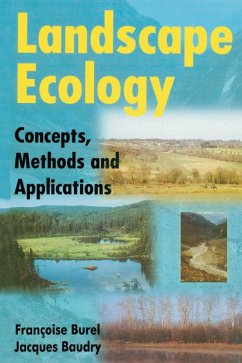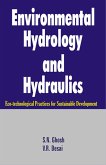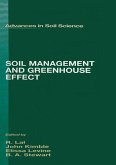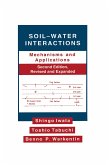Landscape Ecology (eBook, PDF)
Concepts, Methods, and Applications
Redaktion: Burel, Francoise
66,95 €
66,95 €
inkl. MwSt.
Sofort per Download lieferbar

33 °P sammeln
66,95 €
Als Download kaufen

66,95 €
inkl. MwSt.
Sofort per Download lieferbar

33 °P sammeln
Jetzt verschenken
Alle Infos zum eBook verschenken
66,95 €
inkl. MwSt.
Sofort per Download lieferbar
Alle Infos zum eBook verschenken

33 °P sammeln
Landscape Ecology (eBook, PDF)
Concepts, Methods, and Applications
Redaktion: Burel, Francoise
- Format: PDF
- Merkliste
- Auf die Merkliste
- Bewerten Bewerten
- Teilen
- Produkt teilen
- Produkterinnerung
- Produkterinnerung

Bitte loggen Sie sich zunächst in Ihr Kundenkonto ein oder registrieren Sie sich bei
bücher.de, um das eBook-Abo tolino select nutzen zu können.
Hier können Sie sich einloggen
Hier können Sie sich einloggen
Sie sind bereits eingeloggt. Klicken Sie auf 2. tolino select Abo, um fortzufahren.

Bitte loggen Sie sich zunächst in Ihr Kundenkonto ein oder registrieren Sie sich bei bücher.de, um das eBook-Abo tolino select nutzen zu können.
Part I: Introduction: Definition of a Discipline: Emergence of Landscape Ecology in the History of Ecology; Recognition of Heterogeneity in Ecological Systems; Taking Human Activities into Account in Ecological Systems; Explicit Accounting for Space and Time; Landscape Ecology is based on Scientific Theories Linked to Ecology and Related Discipline
- Geräte: PC
- mit Kopierschutz
- eBook Hilfe
Andere Kunden interessierten sich auch für
![Environmental Hydrology and Hydraulics (eBook, PDF) Environmental Hydrology and Hydraulics (eBook, PDF)]() S N GhoshEnvironmental Hydrology and Hydraulics (eBook, PDF)199,95 €
S N GhoshEnvironmental Hydrology and Hydraulics (eBook, PDF)199,95 €![Soil Management and Greenhouse Effect (eBook, PDF) Soil Management and Greenhouse Effect (eBook, PDF)]() John M. KimbleSoil Management and Greenhouse Effect (eBook, PDF)272,95 €
John M. KimbleSoil Management and Greenhouse Effect (eBook, PDF)272,95 €![Soil-Water Interactions (eBook, PDF) Soil-Water Interactions (eBook, PDF)]() IwataSoil-Water Interactions (eBook, PDF)304,95 €
IwataSoil-Water Interactions (eBook, PDF)304,95 €![Soil Biochemistry (eBook, PDF) Soil Biochemistry (eBook, PDF)]() Jean-Marc BollagSoil Biochemistry (eBook, PDF)251,95 €
Jean-Marc BollagSoil Biochemistry (eBook, PDF)251,95 €![Soil Biochemistry (eBook, PDF) Soil Biochemistry (eBook, PDF)]() J. -M. BollagSoil Biochemistry (eBook, PDF)262,95 €
J. -M. BollagSoil Biochemistry (eBook, PDF)262,95 €![Revival: Fractals in Soil Science (1998) (eBook, PDF) Revival: Fractals in Soil Science (1998) (eBook, PDF)]() Philippe BaveyeRevival: Fractals in Soil Science (1998) (eBook, PDF)75,95 €
Philippe BaveyeRevival: Fractals in Soil Science (1998) (eBook, PDF)75,95 €![Ecology of Streams and Rivers (eBook, PDF) Ecology of Streams and Rivers (eBook, PDF)]() Eugene AngelierEcology of Streams and Rivers (eBook, PDF)57,95 €
Eugene AngelierEcology of Streams and Rivers (eBook, PDF)57,95 €
Part I: Introduction: Definition of a Discipline: Emergence of Landscape Ecology in the History of Ecology; Recognition of Heterogeneity in Ecological Systems; Taking Human Activities into Account in Ecological Systems; Explicit Accounting for Space and Time; Landscape Ecology is based on Scientific Theories Linked to Ecology and Related Discipline
Dieser Download kann aus rechtlichen Gründen nur mit Rechnungsadresse in A, B, BG, CY, CZ, D, DK, EW, E, FIN, F, GR, HR, H, IRL, I, LT, L, LR, M, NL, PL, P, R, S, SLO, SK ausgeliefert werden.
Produktdetails
- Produktdetails
- Verlag: Taylor & Francis eBooks
- Seitenzahl: 378
- Erscheinungstermin: 5. Januar 2003
- Englisch
- ISBN-13: 9781439844175
- Artikelnr.: 57530804
- Verlag: Taylor & Francis eBooks
- Seitenzahl: 378
- Erscheinungstermin: 5. Januar 2003
- Englisch
- ISBN-13: 9781439844175
- Artikelnr.: 57530804
- Herstellerkennzeichnung Die Herstellerinformationen sind derzeit nicht verfügbar.
Francoise Burel
Part I: Introduction: Definition of a Discipline: Emergence of Landscape
Ecology in the History of Ecology; Recognition of Heterogeneity in
Ecological Systems; Taking Human Activities into Account in Ecological
Systems; Explicit Accounting for Space and Time; Landscape Ecology is based
on Scientific Theories Linked to Ecology and Related Disciplines Landscpe
Ecology: Definition of a Multidisciplinary Approach: Landscape as
Understood by the Ecologist; Landscape Ecology: An Interdisciplinary
Approach; Landscape Ecology: Application of Results of Fundamental Research
to Conservation Biology and Land Management Part II: Landscape Structure
and Dynamics Analysis of Spatial Structures: Categories of Landscape
Elements; From Sample Plots in a Wood to Woods in a Landscape; Typology of
Patches and Corridors; Basic Concepts for Quantitative Approaches;
Measurement of Heterogeneity; Fragmentation; Connectedness o Return to
Scale Dependence: Contribution of Fractal Geometry o Elements of
Geostatistics; Typologies of Landscape Structures; General Conclusion
Dynamics of Landscapes: Questions on Organization and Dynamics of
Landscapes Stemming from Observation; Changes in Land use on the Global
Scale; Regional Approaches to Changes in Land Use: Variations Depending on
Modes of Measurement; Local Approaches to Changes in Land Cover: Importance
of Spatialization; Dynamics of Valley Landscapes: The Water Course and its
Corridors; Dynamics of Non-Anthropogenic Landscapes; Land cover and
Evolving Landscapes, a General Phenomenon Organization of Landscapes:
Categories of Models; The Concept of Organization; Ecological Organization
of Landscapes; From Farming Systems to Landscape Diversity; General
Approach of Dynamics and Organization of Agrarian Landscapes; Landscape
Dynamics and (Re) Organization: Multi-scale and Multidisciplinary Approach
Part III: Ecological Processes within Landscapes: The Functioning of
Populations at the Landscape Level: Patch Theory and Functioning of
Metapopulations; Multi-habitat Species; Movement in Landscapes; Landscape
Dynamics and the Functioning of Populations; Population Models used in
Landscape Ecology Interspecific Relationships and Biodiversity in
Landscapes: Interspecific Relationships; Biodiversity Geochemical Flows in
Landscapes: Buffer Zones; Erosive Phenomena and Landscape Structure;
Transfers in Watersheds; Conclusion Part IV: Applications to Landscape
Management: Application of Landscape Ecology Concepts to Landscape
Management and Design: Corridor Concept Applied to Development; Considering
Landscape Ecology Concepts in Establishing Transportation Infrastructures;
The Development of Rural Landscapes
Ecology in the History of Ecology; Recognition of Heterogeneity in
Ecological Systems; Taking Human Activities into Account in Ecological
Systems; Explicit Accounting for Space and Time; Landscape Ecology is based
on Scientific Theories Linked to Ecology and Related Disciplines Landscpe
Ecology: Definition of a Multidisciplinary Approach: Landscape as
Understood by the Ecologist; Landscape Ecology: An Interdisciplinary
Approach; Landscape Ecology: Application of Results of Fundamental Research
to Conservation Biology and Land Management Part II: Landscape Structure
and Dynamics Analysis of Spatial Structures: Categories of Landscape
Elements; From Sample Plots in a Wood to Woods in a Landscape; Typology of
Patches and Corridors; Basic Concepts for Quantitative Approaches;
Measurement of Heterogeneity; Fragmentation; Connectedness o Return to
Scale Dependence: Contribution of Fractal Geometry o Elements of
Geostatistics; Typologies of Landscape Structures; General Conclusion
Dynamics of Landscapes: Questions on Organization and Dynamics of
Landscapes Stemming from Observation; Changes in Land use on the Global
Scale; Regional Approaches to Changes in Land Use: Variations Depending on
Modes of Measurement; Local Approaches to Changes in Land Cover: Importance
of Spatialization; Dynamics of Valley Landscapes: The Water Course and its
Corridors; Dynamics of Non-Anthropogenic Landscapes; Land cover and
Evolving Landscapes, a General Phenomenon Organization of Landscapes:
Categories of Models; The Concept of Organization; Ecological Organization
of Landscapes; From Farming Systems to Landscape Diversity; General
Approach of Dynamics and Organization of Agrarian Landscapes; Landscape
Dynamics and (Re) Organization: Multi-scale and Multidisciplinary Approach
Part III: Ecological Processes within Landscapes: The Functioning of
Populations at the Landscape Level: Patch Theory and Functioning of
Metapopulations; Multi-habitat Species; Movement in Landscapes; Landscape
Dynamics and the Functioning of Populations; Population Models used in
Landscape Ecology Interspecific Relationships and Biodiversity in
Landscapes: Interspecific Relationships; Biodiversity Geochemical Flows in
Landscapes: Buffer Zones; Erosive Phenomena and Landscape Structure;
Transfers in Watersheds; Conclusion Part IV: Applications to Landscape
Management: Application of Landscape Ecology Concepts to Landscape
Management and Design: Corridor Concept Applied to Development; Considering
Landscape Ecology Concepts in Establishing Transportation Infrastructures;
The Development of Rural Landscapes
Part I: Introduction: Definition of a Discipline: Emergence of Landscape
Ecology in the History of Ecology; Recognition of Heterogeneity in
Ecological Systems; Taking Human Activities into Account in Ecological
Systems; Explicit Accounting for Space and Time; Landscape Ecology is based
on Scientific Theories Linked to Ecology and Related Disciplines Landscpe
Ecology: Definition of a Multidisciplinary Approach: Landscape as
Understood by the Ecologist; Landscape Ecology: An Interdisciplinary
Approach; Landscape Ecology: Application of Results of Fundamental Research
to Conservation Biology and Land Management Part II: Landscape Structure
and Dynamics Analysis of Spatial Structures: Categories of Landscape
Elements; From Sample Plots in a Wood to Woods in a Landscape; Typology of
Patches and Corridors; Basic Concepts for Quantitative Approaches;
Measurement of Heterogeneity; Fragmentation; Connectedness o Return to
Scale Dependence: Contribution of Fractal Geometry o Elements of
Geostatistics; Typologies of Landscape Structures; General Conclusion
Dynamics of Landscapes: Questions on Organization and Dynamics of
Landscapes Stemming from Observation; Changes in Land use on the Global
Scale; Regional Approaches to Changes in Land Use: Variations Depending on
Modes of Measurement; Local Approaches to Changes in Land Cover: Importance
of Spatialization; Dynamics of Valley Landscapes: The Water Course and its
Corridors; Dynamics of Non-Anthropogenic Landscapes; Land cover and
Evolving Landscapes, a General Phenomenon Organization of Landscapes:
Categories of Models; The Concept of Organization; Ecological Organization
of Landscapes; From Farming Systems to Landscape Diversity; General
Approach of Dynamics and Organization of Agrarian Landscapes; Landscape
Dynamics and (Re) Organization: Multi-scale and Multidisciplinary Approach
Part III: Ecological Processes within Landscapes: The Functioning of
Populations at the Landscape Level: Patch Theory and Functioning of
Metapopulations; Multi-habitat Species; Movement in Landscapes; Landscape
Dynamics and the Functioning of Populations; Population Models used in
Landscape Ecology Interspecific Relationships and Biodiversity in
Landscapes: Interspecific Relationships; Biodiversity Geochemical Flows in
Landscapes: Buffer Zones; Erosive Phenomena and Landscape Structure;
Transfers in Watersheds; Conclusion Part IV: Applications to Landscape
Management: Application of Landscape Ecology Concepts to Landscape
Management and Design: Corridor Concept Applied to Development; Considering
Landscape Ecology Concepts in Establishing Transportation Infrastructures;
The Development of Rural Landscapes
Ecology in the History of Ecology; Recognition of Heterogeneity in
Ecological Systems; Taking Human Activities into Account in Ecological
Systems; Explicit Accounting for Space and Time; Landscape Ecology is based
on Scientific Theories Linked to Ecology and Related Disciplines Landscpe
Ecology: Definition of a Multidisciplinary Approach: Landscape as
Understood by the Ecologist; Landscape Ecology: An Interdisciplinary
Approach; Landscape Ecology: Application of Results of Fundamental Research
to Conservation Biology and Land Management Part II: Landscape Structure
and Dynamics Analysis of Spatial Structures: Categories of Landscape
Elements; From Sample Plots in a Wood to Woods in a Landscape; Typology of
Patches and Corridors; Basic Concepts for Quantitative Approaches;
Measurement of Heterogeneity; Fragmentation; Connectedness o Return to
Scale Dependence: Contribution of Fractal Geometry o Elements of
Geostatistics; Typologies of Landscape Structures; General Conclusion
Dynamics of Landscapes: Questions on Organization and Dynamics of
Landscapes Stemming from Observation; Changes in Land use on the Global
Scale; Regional Approaches to Changes in Land Use: Variations Depending on
Modes of Measurement; Local Approaches to Changes in Land Cover: Importance
of Spatialization; Dynamics of Valley Landscapes: The Water Course and its
Corridors; Dynamics of Non-Anthropogenic Landscapes; Land cover and
Evolving Landscapes, a General Phenomenon Organization of Landscapes:
Categories of Models; The Concept of Organization; Ecological Organization
of Landscapes; From Farming Systems to Landscape Diversity; General
Approach of Dynamics and Organization of Agrarian Landscapes; Landscape
Dynamics and (Re) Organization: Multi-scale and Multidisciplinary Approach
Part III: Ecological Processes within Landscapes: The Functioning of
Populations at the Landscape Level: Patch Theory and Functioning of
Metapopulations; Multi-habitat Species; Movement in Landscapes; Landscape
Dynamics and the Functioning of Populations; Population Models used in
Landscape Ecology Interspecific Relationships and Biodiversity in
Landscapes: Interspecific Relationships; Biodiversity Geochemical Flows in
Landscapes: Buffer Zones; Erosive Phenomena and Landscape Structure;
Transfers in Watersheds; Conclusion Part IV: Applications to Landscape
Management: Application of Landscape Ecology Concepts to Landscape
Management and Design: Corridor Concept Applied to Development; Considering
Landscape Ecology Concepts in Establishing Transportation Infrastructures;
The Development of Rural Landscapes







